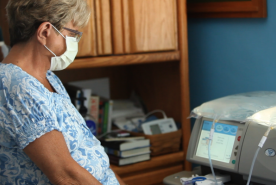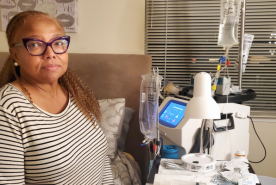How your access works
A hemodialysis access, or vascular access, is a way to reach the blood for hemodialysis. The access allows blood to travel through soft tubes to the dialysis machine where it is cleaned as it passes through a special filter, called a dialyzer. An access is placed by a minor surgery. As a hemodialysis patient, your access is one of the following:
- Fistula: an access made by joining an artery and vein in your arm.
- Graft: an access made by using a piece of soft tube to join an artery and vein in your arm.
- Catheter: a soft tube that is placed in a large vein, usually in your neck.
If your access is a fistula or graft, your nurse or technician will place two needles into the access at the beginning of each treatment. These needles are connected to soft tubes that go to the dialysis machine. Your blood goes to the machine through one of the tubes, gets cleaned in the dialyzer, and returns to you through the other tube. If your access is a catheter, it can be connected directly to the dialysis tubes without the use of needles.
A fistula should be considered the first choice for your access because it generally lasts longer and has fewer problems such as infections and clotting. However, some patients may not be able to receive a fistula because their blood vessels are not strong enough. A graft is considered the second choice for an access. Catheters are generally used as a temporary access, but sometimes they are permanent. Sometimes, it may be possible to switch to a fistula from another type of access. If you do not have a fistula, ask your dialysis care team if a switch would be possible for you.
Fistula or graft
- Wash with an antibacterial soap each day, and always before dialysis. Do not scratch your skin or pick the scab.
- Check for redness, a feeling of excess warmth, or the beginning of a pimple on any area of your access.
- Ask your dialysis care team to rotate the needles when you have your dialysis treatment.
Keeping your access working
Your dialysis care team will check your access often to make sure it is working well. An access that is not working well can decrease the amount of dialysis you receive. Your dialysis care team will teach you how to check your fistula or graft at home each day. Here are some tips you should follow to help keep a fistula or graft working longer:
- Check the blood flow several times each day by feeling for a vibration, also called a pulse or thrill. If you do not feel this, or if there is a change, call your doctor or your dialysis center.
- Do not wear tight clothes or jewelry on your access arm.
- Do not carry anything heavy or do anything that would put pressure on the access.
- Do not sleep with your head on the arm that has your access.
- Do not let anyone use a blood pressure cuff on your access arm.
- Do not let anyone draw blood from your access arm.
- Do not be afraid to ask your dialysis care team to rotate needle sites.
- Apply only gentle pressure to the access site after the needle is removed. Too much pressure will stop the flow of blood through the access.
- If you have breakthrough bleeding after you have dialysis, apply gentle pressure to the needle site with a clean towel or gauze pad. If the bleeding does not stop in 30 minutes, call your doctor or your dialysis center.
Check out our online communities to connect, learn more and hear from others going through similar experiences.
If access problems occur
Sometimes, even when you are very careful, your access may clot or become infected. If an infection occurs, your doctor will order antibiotics for you. If your access develops a clot, you may need to go to the hospital for treatment. Removing the clot can usually be done on an outpatient basis, and you will not need to stay overnight.








